You can also use these black or white paints as “stand alones” with other paints you love, or use the pairings we’ve selected for you here. These curated colors on their own are also great on cabinets or furniture.
100 Years After Malevich’s Black Square, Whitechapel Gallery Shows the Artist is More Relevant Than Ever
Two years before the tempestuous Russian Revolution shook the world with its radical ideology and ruthless methods, a 30-something painter born in modern-day Ukraine kickstarted a historic uprising all his own. Kazimir Malevich’s Black Square (1915), a diminutive jet-black oil square surrounded by a pristine white linen border, was a rebellion against the dominance of depicting real life—an insurrection against figuration.
Kasimir Severinovich Malevich
Black and White. Suprematist Composition, 1915
“Adventures of the Black Square: Abstract Art and Society 1915-2015” at Whitechapel Gallery, London (2015)
Peter Halley
Auto Zone, 1992
“Adventures of the Black Square: Abstract Art and Society 1915-2015” at Whitechapel Gallery, London (2015)
Advertisement
“Up until now there were no attempts at painting as such, without any attribute of real life,” declared Malevich, in a text accompanying Black Square’s first showing—exactly a century ago—at “The Last Futurist Exhibition of Paintings: 0.10” in Petrograd (now Saint Petersburg), Russia. “Painting was the aesthetic side of a thing, but never was original and an end in itself.” This is not entirely true. There were Mondrian’s contemporaneous warped-checkerboard geometries. And the Islamic world’s tradition of abstraction is centuries old. What Malevich did ostensibly achieve, however, is the distillation of abstract painting to its most fundamental core: an image without reference to reality.
“Adventures of the Black Square,” Installation View. Courtesy of Whitechapel Gallery. Photo: Stephen White
“Adventures of the Black Square: Abstract Art and Society 1915-2015” is a landmark, sprawling show at London’s Whitechapel Gallery, which spreads over six exhibition spaces and includes over 100 artists. It takes his bijou quadrilateral as a starting point from which to explore how this strand of abstraction was adopted and appropriated across the world. From the aging nobility of Malevich’s Black Quadrilateral (undated), to the captivating beauty of Red Quadrilateral (undated) and the now-cracked charm of Black and White. Suprematist Composition (1915), the exhibition proceeds to reflect on the vast swathes of geometric, methodical abstraction, which Malevich influenced (as opposed to the fertile freestyle forms in the lineage of Joan Miró and Cy Twombly).
“Adventures of the Black Square,” Installation View. Courtesy of Whitechapel Gallery. Photo: Stephen White
This almost mathematical, mechanical approach to art came to be considered the most democratic form in what was—as the curators Iwona Blazwick and Magnus af Petersens argue—the most democratic century in human history. Spectrums, shades, and degrees are given equal value. Also on view, Alexander Rodchenko’s photographs of Vladimir Shukhov’s spiralling Moscow radio tower are a sumptuous study of shape. László Moholy-Nagy’s shots of the Berlin Radio Tower reduce a titanic structure to pleasing bird’s-eye symmetry. Josef Albers’s Homage to the Square (1963) meditates on the properties of color in a layered, lemon-yellow-to-burnt-umber spectrum. And the off-kilter lines of Jeffrey Steele’s Third Syntagmatic (1965) bisect the canvas with infinitesimal angles.
Gabriel Orozco
Lights Sign # 1 (Korea), 1995
“Adventures of the Black Square: Abstract Art and Society 1915-2015” at Whitechapel Gallery, London (2015)
Zhao Yao 赵要
Spirit Above All 1-93A, 2012
“Adventures of the Black Square: Abstract Art and Society 1915-2015” at Whitechapel Gallery, London (2015)
The exhibition is divided into four wider themes: Utopia, Architectonics, Communication, and The Everyday. Though, there is much bleeding between them. Fernand Léger’s Ballet Mécanique (1924), a 35mm black-and-white short film, mimics the clockwork structure of daily life through the then-burgeoning communication medium. In a nuanced twist, the Brazilian duo Gasparian and Serpa’s works on display evoke dazzling binary code data, with the latter typing out a series of upper and lower case o’s on his 1950s Corona typewriter for 33 Untitled (1955). Elsewhere, art magazines on display such as Belgrade’s Zenit and Buenos Aires’s Arte Concreto reveal the extent to which abstraction percolated globally.
“Adventures of the Black Square,” Installation View. Courtesy of Whitechapel Gallery. Photo: Stephen White
This is perhaps the most significant argument that “Adventures of the Black Square” posits. Despite the many mesmeric works on display from the West (Dora Maurer of the Hungarian avant garde’s 1979 multiple-exposure work Seven Rotations 1 to 6 being an extraordinary example), the exhibition’s tracking of the non-Western is a fresh, original perspective. It follows the Latin American shift away from the figurative paintings of their European Catholic colonizers, and even shimmies up to the modern day. In the film Retoque / Painting (2008), Francis Alÿs repaints the old territory marks of the Panama Canal. And Liu Wei’s Purple Air (2014) responds to the rampant change of 21st-century China with soaring lines of stratified paint.
Benjamin Moore: Space Black 2119-10 & Decorator’s White CC-20
We love how this soft black tone simply stands out from the crowd. It’s an impressive smoky hue that illuminates a world all its own with its pure and deep color. We can definitely see this beauty being used in a hallway or office as it generates a dramatic but subtle statement. A great option alongside it would be this popular fan-favorite, Decorator’s White! Introducing it into any room, and under any applications, creates that light-hearted touch that’s an ideal complement to any color beside it.

Sherwin Williams: Tricorn Black 251-C1 & Pure White SW 7005
We know what you’re thinking, this rich jet black is a showstopper. We couldn’t agree with you more! The vividly bold shade has a somewhat original sharpness to it. Painting this in a living room or dining room would be a great canvas for this beauty, so are just your interior door and trim! Plus, we think it looks great paired with a striking white for a stylish modern look. As a bonus, both are great for your exterior as well. What a harmonious duo!
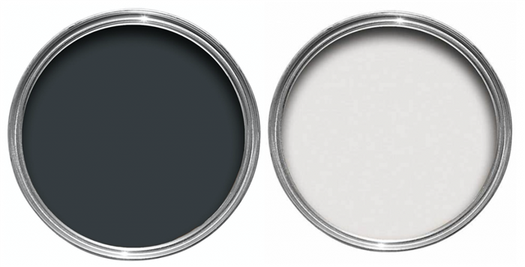
Farrow & Ball: Black Blue No.95 & Wevet No. 273
We adored this black-gray pigment because of its deep tone showing no sign of going out of trend. This sophisticated hue really impressed us with its ideal balance between gray and black! What a combination! We think you’d agree with us when we say that we can see it being used in hallways and bedrooms to enhance the sense of coziness. Pairing it with this warm white pigment creates a wonderful balance. Next to this black-gray, this white would look stunning when applied to millwork.
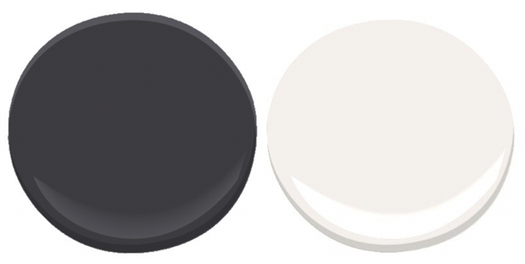
Robert Motherwell: Pure Painting
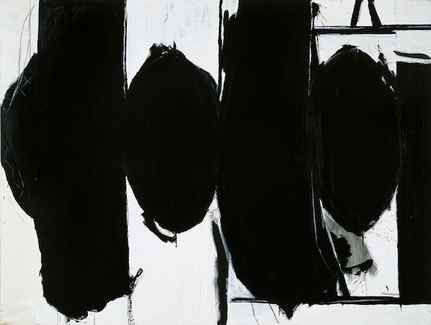
Robert Motherwell, Elegy to the Spanish Republic, 1960. Boucour Magna paint on canvas, unframed: 72 x 96 1/4 x 1 inches, framed: 73 1/2 x 97 3/4 x 1 3/4 inches. Collection of the Modern Art Museum of Fort Worth, Museum purchase, The Friends of Art Endowment Fund.
On View
Modern Art Museum Of Fort Worth, Texas
Robert Motherwell: Pure Painting
June 4–September 17, 2023
The retrospective exhibition of Robert Motherwell’s paintings currently at the Modern Art Museum of Fort Worth is exhilarating. I came away with the sense that he has lived in totality, and that an infinite reservoir of awareness is in service for him at the moment of creation. The quality of imagery in the works on view reminded me once again why I’ve long been such an admirer of this artist. His paintings reveal accumulations of decisions with the brush that are the result of direct action, which are then often redirected by his further work on the canvas. I was reminded of something he said: “The painting comes out of the correction of mistakes by feeling . . . . The final picture is the process arrested at the moment when what I was looking for flashes into view.” This self-reflection about the process of painting reminds us that Motherwell, perhaps more than any of his colleagues of the New York School (a term he coined in 1950), was possessed with an unusual aptitude for intellectual inquisitiveness about artistic invention—and also about everything that fulfilled his lifelong passion and commitment to advance the importance of modern art in America. This was partly a social engagement, but most especially it was a deeply personal one, which involved creating art with tremendous seriousness and wonderment.
Motherwell’s synthesis of the social and the personal, the intellect and intuition, is something that I greatly admire—especially since I know that he was aware that the two are inseparable, and that both elements of this polarity necessarily impacted his understanding of the world and of himself. This kind of constant mediation between internal and external worlds can be referred to as “mind-in-action” or “intellectual senses,” without which it would be impossible to create or to recognize the significance inherent in patterns, rhythms, and spatial discrepancies. In addition to the visual excitement and pleasure provoked by this exhibition, the works on display also demonstrate that Motherwell absorbed both instinct and intellect in his early formation, and his varied calibrations of the balances between them provided an endless stream of rich resources that fed his remarkable artistic journey.
One exceptional aspect of Motherwell’s career is just how quickly he reached his full artistic maturity, in 1941, at the age of twenty-six, only a few months after he decided to dedicate his life to being an artist. Surely his early training in philosophy contributed to his understanding of how forms could embody both ideas and feelings. But his studies with Arthur O. Lovejoy and D.W. Prall at Harvard, and his immersion in the writings of John Dewey and Alfred North Whitehead on pragmatism and process philosophy, as well as his brief study of art history with Meyer Schapiro, were only a prelude to the kinds of insights that led him to explore psychic automatism with Roberto Matta during the summer of 1941.
From our current perspective, the way Motherwell managed to mobilize his personal practice in the studio with his social activism in the outside world remains an unimaginable achievement indeed. He had his first one-man show at Peggy Guggenheim’s Art of This Century gallery in 1944, and in 1965, at the age of fifty, he had one of the first retrospectives by a New York School artist at the Museum of Modern Art. All the while, he was the leading spokesman for avant-garde art in many ways: as the inaugural editor of the surrealist magazine VVV; as editor of Problems of Contemporary Art (1945–48) and co-editor of Possibilities magazine (1947–48); as co-editor with Ad Reinhardt of Modern Artists in America (1951), and most especially as editor of the influential Documents of Modern Art series, begun in 1944, for which he personally edited The Dada Painters and Poets (1951), which remains even today the most comprehensive and important anthology of Dada writings in any language. And through all of this, he was constantly evolving as an artist—as is now clearly evident in this magisterial exhibition of his paintings, selected and beautifully installed by curator Susan Davidson.

Robert Motherwell, La Belle Mexicaine (Maria), 1941. Oil on canvas, 29 1/2 × 23 3/4 inches. © Copyright 2023 Dedalus Foundation, Inc. / Licensed by the Artists Rights Society (ARS), NY.
“Having a retrospective is making a will,” Motherwell remarked on the occasion of his 1965 retrospective at MoMA. This exhibition of Motherwell’s paintings, which follows a recent retrospective of his drawings at the Menil Drawing Institute, offers a timely opportunity to view the artist in his natural alchemy within painting culture. From the very start, we are aware of the impressive range of his imagery. As we walk up to the second floor of the museum, the first work we see is the artist’s iconic Elegy to the Spanish Republic (ca. 1962/82), a wonderfully monumental example of his most renowned series. And right after this is his earliest mature painting, La Belle Mexicaine (Maria) (1941), which impressively reveals the complexities of his painterly thought at the outset of his career. This painting is at once a portrait and an ensemble of vividly rendered forms, in which random stains and scratched marks float on the relatively thin yet richly patinated surface that contains the woman’s face and torso. The horizontal, impetuously painted wet-on-wet brushstrokes in the dark gray background are set against the irregularly painted vertical stripes below the woman’s body, which is surrounded by bold black outlines that tie together the relationship between representation and abstraction, at once emphasizing the flatness of the picture plane and the physicality of the woman represented. In this painting, as in so many other works in the show, we are intensely aware of both the finished, iconic image and the process behind its creation.

Installation view: Robert Motherwell: Pure Painting, Modern Art Museum of Fort Worth, TX, 2023. Courtesy Modern Art Museum of Fort Worth.
Right from the first room, one recognizes how Motherwell both asserts and rings variations on the rectilinear structure of the cubist grid. One is also intensely aware of how paint is deployed in different ways to achieve varied expressive effects. For example, in Spanish Picture with Window (1941) and Recuerdo de Coyoacán (1942), the surfaces range from heavily painted impastos to more tenderly engendered networks of lines. And both paintings are early instances of Motherwell’s masterful deployment of areas of stripes. The contrasts between areas of stripes, and even splatters, and broadly rendered planes creates a visual dialogue in which Motherwell’s tactile sensibility asserts his equivalence of physiognomic domains of the specific. In these two paintings, the stripes tellingly appear in relatively small but crucial areas. But in The Little Spanish Prison (1941–44), the stripes dominate the composition, in a way that anticipates major artists of the next generation, such as Frank Stella, Kenneth Noland, and Sean Scully, among others. Particularly striking in this painting is the small horizontal red stripe that punctuates the composition. (It was at one time painted black, but Motherwell changed it to red around 1969 in order to give it even greater emphasis—an excellent example of his ongoing engagement with many of his works even after they were apparently finished.)
This kind of accenting or punctuation brought to my mind a way in which Motherwell’s love for philosophy, literature, poetry, and music, which were already present in his early formation, was reflected in his paintings. I was reminded of Theodor Adorno’s comment about the importance of punctuation in writing, and of Adorno’s assertion that “The test of a writer’s sensitivity in punctuation is the way he handles parenthetical material.” The visual equivalent of punctuation plays an important role in Motherwell’s work. It is most apparent in the very considered way that he treats the spacing between forms, and most especially in his use of forms that function in relation to space somewhat the way that commas, full stops, colons, exclamation marks, and parentheses modulate the flow of written words. This kind of highly punctuated spacing is seen most dramatically in the “Elegy” paintings, but is also present in different ways throughout his works. A parallel in music that Motherwell also paid great attention to was the way in which silences are used between punctuated flows of sounds. The large areas of white spaces in so many of Motherwell’s paintings, for example, are deployed like the silences in music—or even like parenthetical thoughts in writing: they exert a presence not only on our attention, but also engage what might be called our subliminal inattention.
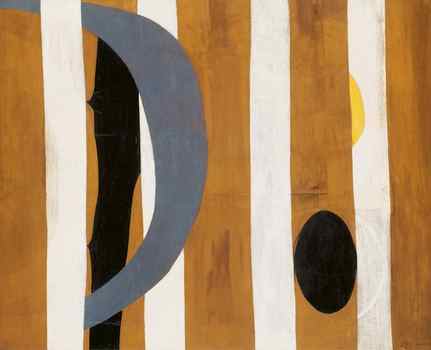
Robert Motherwell, Wall Painting with Stripes, 194445. Oil on canvas, 54 x 67 1/8 inches. The Art Institute of Chicago. Purchased with funds provided by Muriel Kallis Steinberg Newman in honor of her grandchildren, Ellen Steinberg and Peter Steinberg; gift of Lannan Foundation. © 2023 Dedalus Foundation, Inc. / Artists Rights Society (ARS), New York.
The different ways that Motherwell used stripes in Little Spanish Prison, for example—as an evenly inflected ensemble of vertical forms, and also as a dramatic horizontal red punctuation—are indicative of the suppleness and flexibility of his pictorial thinking. Equally impressive is the way that he is capable of converting into various functions various kinds of emphasis in the way he punctuates his forms. In both their subtle and more obvious forms of punctuation they’re capable of adapting to a particular condition and environment in each painting. This ranges from presenting themselves in various thicknesses and lengths at the top margin of the large white planes in Spanish Picture with Window to functioning as a structure of looming monumentality in the boldly inflected Wall Painting with Stripes (1944–45), a painting in which nine ochre and white vertical stripes of unequal width provide a resonant background for three clearly punctuated forms: a black, tree-like vertical, a gray parenthetical form, and a large black dot that arrests the eye like the period at the end of a sentence. These forms are at once harmonious and a form of spatial rupture. They move the eye smoothly from left to right, but at the same time, the punctuating forms that are played against them also buckle and bend our line of vision. Wall Painting with Stripes is at once unmistakably monumental, painted with a masonry texture and heavily-worked surface, and at the same time sensually tactile, melancholy, and glowingly poetic.
Although we most often think of Motherwell in terms of dynamic gestures associated with psychic automatism and pure abstraction, between 1944 and 1948 he was able to achieve a unique synthesis of automatism and synthetic cubism in a number of figurative works. This is dramatically evident in three contemporaneous paintings that are displayed on a single wall: The Emperor of China (1947), The Checkered Skirt (1947), and The Homely Protestant (1948). These three paintings embody similar explorations in ways of representing the human figure, along with the use of subtle geometry and a kind of painterly rendering that makes them vividly present and tangible. And in an impressive curatorial tour de force, an adjacent wall contains two of Motherwell’s most powerful large abstract paintings—The Voyage (1948–49), which gave birth to the “Elegy to the Spanish Republic” series, and Elegy to the Spanish Republic No. 35 (1954–1958), one of the most powerful paintings in that series.
With the introduction of the “Elegy” paintings, which became a hallmark of Motherwell’s artistic achievement, we notice an appreciable change in temperature: the presence of large, powerful areas of black in Motherwell’s later paintings is undoubtedly dramatic. In some, such as A Sculptor’s Picture, with Blue (1958), and Two Figures with Cerulean Blue Stripe (1960), figure and ground seem to have been painted all at once with great immediacy, and the process of creation appears to be the product of intense negotiations between volumetric form and the inherent flatness of the surface. In other paintings, black as a predominately painted field pushes the negative space to its extreme measure, from which the image cautiously emerges, as in Spanish Painting with the Face of a Dog (1958–60) or Black and White Plus Passion (1958).
During the 1960s, Motherwell was particularly receptive to the emergence of Color Field painting, and sometimes applied large areas of solid colors that stained and spread across the canvas, resulting in an overall consistency of form and process. Motherwell was able to adapt this process so that it harmonized with his own highly idiosyncratic automatism, as can be seen in the two monumental canvases that are installed majestically on the two large walls of room three: in The Voyage: Ten Years After (1960–61/1962 ), we see a large drip gesture in blue on the left side of an open white canvas in dialogue with the much larger pool of stained burnt umber, anchored by a black vertical on the right, framed by two vast areas of yellow ochre on the sides of the canvas. Similarly, in Black on White (1961), we see how a sweeping curved gesture was first painted in blue only to be repainted with black on top; and how, with lightning speed, the artist painted the second gesture also in black, even bolder as a counter-movement; both of these forms are perfectly calibrated in relation to the stain of Indian red that hovers above the paired yellow and orange brushstrokes below.
Among the many monumental and architectonic large-scale works, I was particularly thrilled to see in room four what I feel is the most perfect painting among the “Elegy to the Spanish Republic” pictures. Elegy to the Spanish Republic No. 103 (1965) was the only time he painted this iconic imagery with a complete confidence in graphic legibility without any revision. On the contrary, Elegy to the Spanish Republic No. 100 (1962–63/1973–75), as the years indicate, was unusual not only in its long and extended horizontal format, but also because of the endless revisions that were made in order to render the forms and the in-between spaces to their fullest expressiveness. This picture truly attests to Motherwell’s impressive capacity for mediating scale, as well as for achieving an abstract monumentality and majesty. In New England Elegy No. 2 (1965–66), by contrast, with its four unequally sized black angular gestures enclosing the half-drip-half-stained blue form in the middle, I suspect that the artist must had taken a soft, smaller brush to accentuate a variety of distinctly different kinds of edges, from slipping, sliding, and nudging, to agitating and dripping.
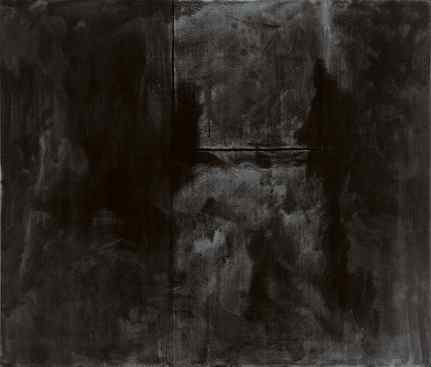
Robert Motherwell, In Platos Cave, 1973. Acrylic and charcoal on canvas, 72 × 84 3/4 inches. Philadelphia Museum of Art: Gift (by exchange) of Miss Anna Warren Ingersoll and partial gift of the Dedalus Foundation, Inc., 1998. © Copyright 2023 Dedalus Foundation, Inc. / Licensed by the Artists Rights Society (ARS), NY.
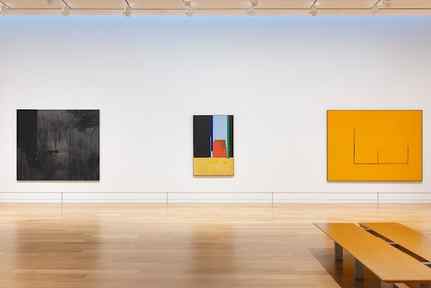
Installation view: Robert Motherwell: Pure Painting, Modern Art Museum of Fort Worth, TX, 2023. Courtesy Modern Art Museum of Fort Worth.
At this point in the exhibition, one of the most rewarding experiences was to see the most singularly sublime painting ever painted solely in one color, namely In Plato’s Cave (1973). Painted all in black, partially in opaque wet-on-wet, and partially with the canvas tilted to control the pouring of thin washes, stains, and drips, which both surround and permeate the three drawn black charcoal lines, the result is stunningly both atmospheric and claustrophobic at the same time. Quite the opposite feeling is produced by Open White and Black (1969), which evokes a resolutely matter-of-fact flatness, and yet is so wondrously spatial that I don’t think I’ve ever seen a painting in which a sense of vast space is deployed so economically: with only five lines, drawn in black charcoal, three long vertical ones, along with one horizontal below forming a window-like structure from the upper part of the canvas; while two short lines suggest the existences of other activities in the field of a warm and coolly shaded linen. The feeling of space and of poetic light emerges from the relationship between all the drawn lines that share tremendous subtle differences in their characters. The way the second vertical line is painted over one-quarter way through with white paint from the top, while the horizontal line below was painted against its bottom edge by a passage of white paint, appears like the bottom of a pageant of clouds. This kind of concentrated distillation is precisely what brought Motherwell’s pictorial thinking closer to Zen Buddhism, and Eastern philosophy in general, than most of his peers of the New York School. A similar economy of means, along with a specific feeling for monumental form and edges, is clearly seen in both Open No. 9: In Green on Gray with Black Stripe (1967) and Open No. 150: In Black and Cream (Rothko Elegy) (1970). In the former the whole canvas was painted first in yellow ochre, followed by the imperfect green rectangle (with its left edge slightly tilted from the perpendicular), then a field of neutral gray was judiciously applied close to its edges. By cutting the gray paint to the green configuration on both its right and bottom edges a sliver of ochre color below was revealed, only to be drawn with a straight black charcoal line in-between to bring our attention closer to this supple finesse. This drawn line, however subtle in its appearance, has an equal weight to that of the painted black vertical band on the right side of the painting. And in the other monumental “Open,” the Rothko Elegy, the “Open” form is painted with a pitch-perfect rectangle of creamy white, just off the central axis, and in the black field that reveals just a glimmer of transparency, an enormous depth of feeling is evoked with the most minimal means. It is a classic among Motherwell’s works of this period—an “Elegy” in the form of an “Open.”
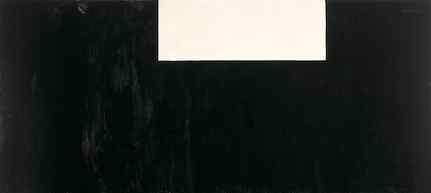
Robert Motherwell, Open No. 150 in Black and Cream (Rothko Elegy), 1970. Acrylic on canvas, 69 x 204 1/4 inches. Collection of the Modern Art Museum of Fort Worth, Museum purchase, TheFriends of Art Endowment Fund. © Copyright 2023 Dedalus Foundation, Inc. / Licensed by the Artists Rights Society (ARS), NY.
Motherwell continued to work on a monumental scale right to the end of his life, as can be seen in the rooms at the conclusion of this exhibition, which contain a remarkable ensemble of late works, including The Grand Inquisitor (1989–90), Elegy to the Spanish Republic No. 172 (with Blood) (1989–90), Face of the Night (For Octavio Paz) (ca. 1977-79/1981), and one of his masterpieces of the late black-and-white works, Stephen’s Iron Crown (1981), which is as ecstatically gorgeous as his drawing of the same image, Drunk with Turpentine (1979). All of these reveal Motherwell’s tireless explorations in the deployment of serial themes and directly stated forms.
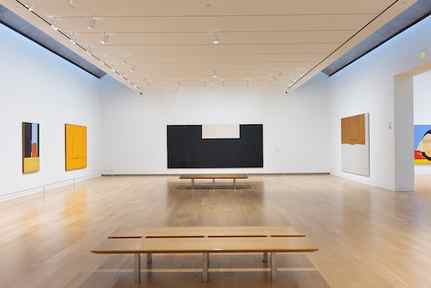
Installation view: Robert Motherwell: Pure Painting, Modern Art Museum of Fort Worth, TX, 2023. Courtesy Modern Art Museum of Fort Worth.
As I reflect on my experience of this marvelous exhibition, I want to inject a personal note by relating my long-standing enthusiasm for Motherwell’s accomplishment to my own aspirations and voyage of self-discovery. Seeing this particular selection of Motherwell’s work, I cannot help but think that he, as an artist, writer, editor, and spokesman for the New York School, and as a tireless advocate of modern art, has over the years served as a model for the kinds of things that I have wanted to accomplish with my own life. As an artist and as a writer, Motherwell provides a wonderful model for possibilities of self-realization, for wanting one’s life to resonate with others in several different realms—art, ideas, social thought, and political principles. It is important to remember that Motherwell passionately believed that every aesthetic decision is ultimately ethical. Motherwell was able to create works, as a friend of mine recently noted, that were abstract but also intensely personal, lyrical but also often infused with a sense of tragedy; and he was always acutely aware of the degree to which painters have to be open to whatever happens between themselves and the canvas, no matter how unexpected.
So I personally admire Motherwell both as an artist and as someone who embodies a kind of model for how one can act in the world. As I explore my own flashes of clarity while looking at such a luminous retrospective of this American master, I’m reminded of what Charles Baudelaire once declared: “An artist is only an artist on condition that he neglects no aspect of his dual nature. This dualism is the power of being oneself and someone else at one and the same time.”





